Corporate Governance Report: Compliance, Disclosure, and Control
VerifiedAdded on 2023/06/11
|9
|2314
|251
Report
AI Summary
This report provides an overview of corporate governance, focusing on legal compliance, disclosure requirements, management of files and records, and internal control. It examines applicable legislation such as the Corporations Act 2001 and ASX listing rules, emphasizing the importance of periodic and continuous disclosure, including financial and directors' reports. The report details the legal requirements for managing financial records and highlights the role of internal controls in ensuring operational effectiveness, reliable financial reporting, and compliance with regulations. It further explains the link between internal control and corporate governance, identifying the responsibilities of management and auditors in maintaining a controlled environment. The conclusion underscores the significance of internal control audits in safeguarding organizations and enhancing their efficiency, with references to relevant academic sources.
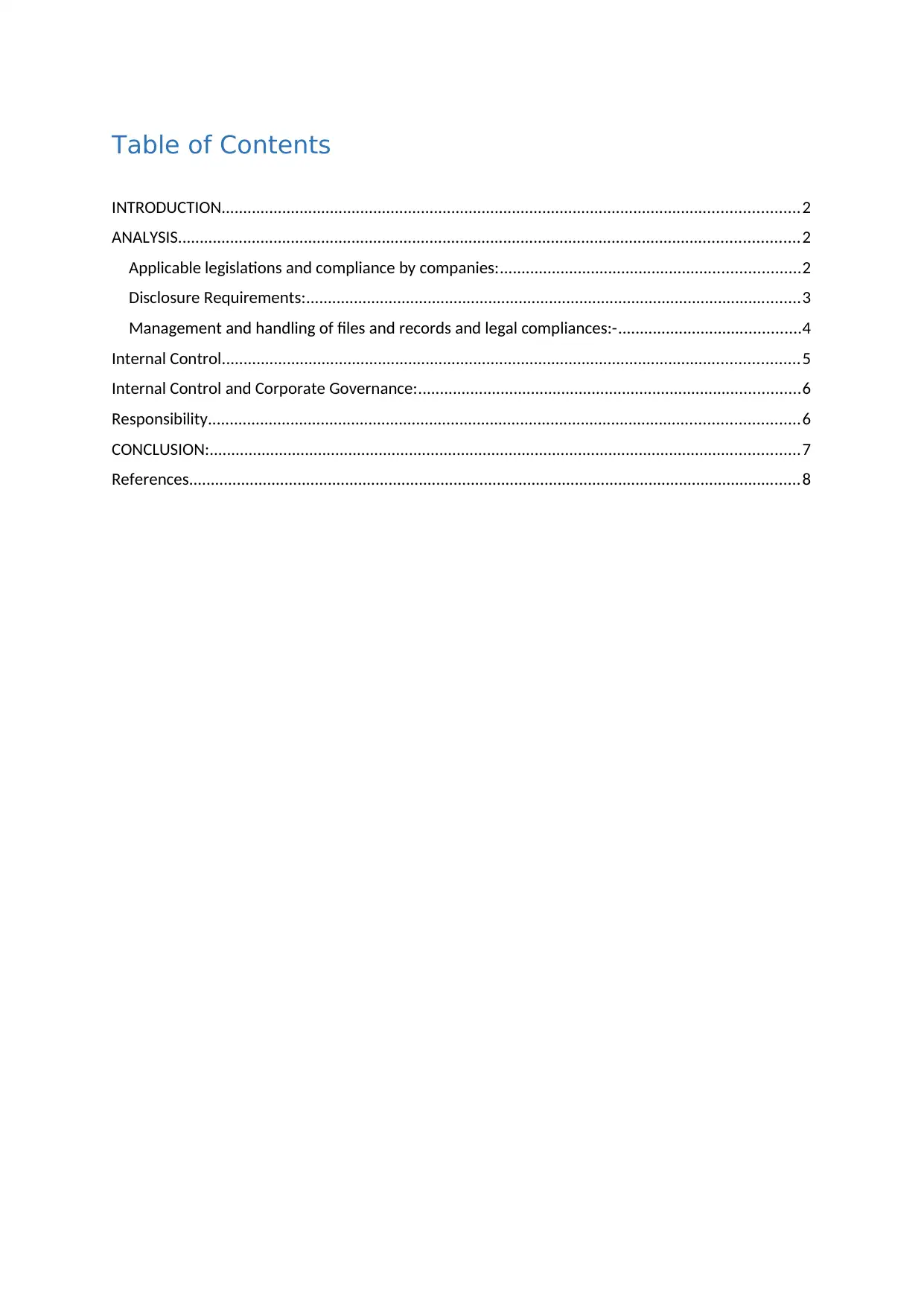
Table of Contents
INTRODUCTION.....................................................................................................................................2
ANALYSIS...............................................................................................................................................2
Applicable legislations and compliance by companies:.....................................................................2
Disclosure Requirements:..................................................................................................................3
Management and handling of files and records and legal compliances:-..........................................4
Internal Control.....................................................................................................................................5
Internal Control and Corporate Governance:........................................................................................6
Responsibility........................................................................................................................................6
CONCLUSION:........................................................................................................................................7
References.............................................................................................................................................8
INTRODUCTION.....................................................................................................................................2
ANALYSIS...............................................................................................................................................2
Applicable legislations and compliance by companies:.....................................................................2
Disclosure Requirements:..................................................................................................................3
Management and handling of files and records and legal compliances:-..........................................4
Internal Control.....................................................................................................................................5
Internal Control and Corporate Governance:........................................................................................6
Responsibility........................................................................................................................................6
CONCLUSION:........................................................................................................................................7
References.............................................................................................................................................8
Paraphrase This Document
Need a fresh take? Get an instant paraphrase of this document with our AI Paraphraser
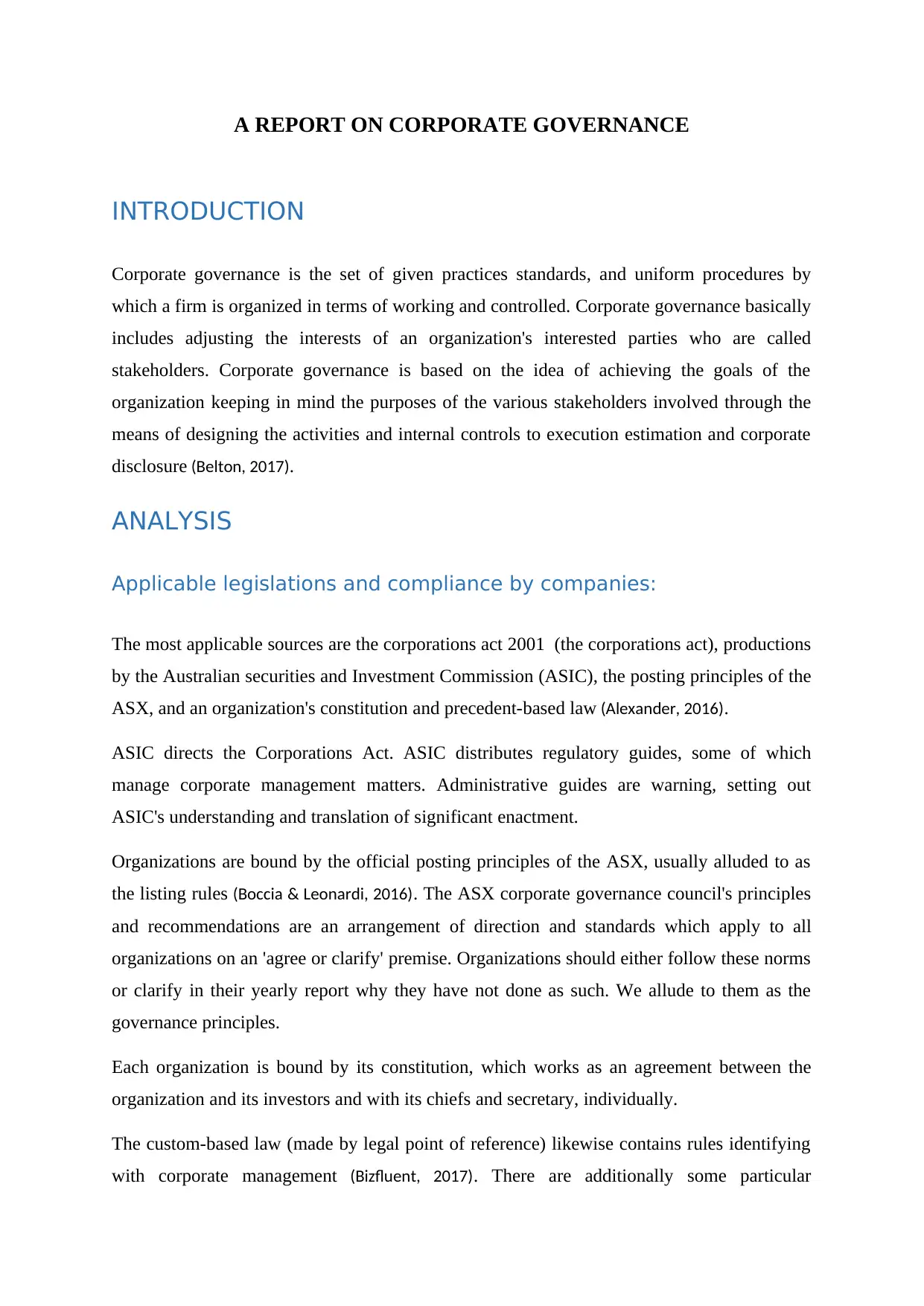
A REPORT ON CORPORATE GOVERNANCE
INTRODUCTION
Corporate governance is the set of given practices standards, and uniform procedures by
which a firm is organized in terms of working and controlled. Corporate governance basically
includes adjusting the interests of an organization's interested parties who are called
stakeholders. Corporate governance is based on the idea of achieving the goals of the
organization keeping in mind the purposes of the various stakeholders involved through the
means of designing the activities and internal controls to execution estimation and corporate
disclosure (Belton, 2017).
ANALYSIS
Applicable legislations and compliance by companies:
The most applicable sources are the corporations act 2001 (the corporations act), productions
by the Australian securities and Investment Commission (ASIC), the posting principles of the
ASX, and an organization's constitution and precedent-based law (Alexander, 2016).
ASIC directs the Corporations Act. ASIC distributes regulatory guides, some of which
manage corporate management matters. Administrative guides are warning, setting out
ASIC's understanding and translation of significant enactment.
Organizations are bound by the official posting principles of the ASX, usually alluded to as
the listing rules (Boccia & Leonardi, 2016). The ASX corporate governance council's principles
and recommendations are an arrangement of direction and standards which apply to all
organizations on an 'agree or clarify' premise. Organizations should either follow these norms
or clarify in their yearly report why they have not done as such. We allude to them as the
governance principles.
Each organization is bound by its constitution, which works as an agreement between the
organization and its investors and with its chiefs and secretary, individually.
The custom-based law (made by legal point of reference) likewise contains rules identifying
with corporate management (Bizfluent, 2017). There are additionally some particular
INTRODUCTION
Corporate governance is the set of given practices standards, and uniform procedures by
which a firm is organized in terms of working and controlled. Corporate governance basically
includes adjusting the interests of an organization's interested parties who are called
stakeholders. Corporate governance is based on the idea of achieving the goals of the
organization keeping in mind the purposes of the various stakeholders involved through the
means of designing the activities and internal controls to execution estimation and corporate
disclosure (Belton, 2017).
ANALYSIS
Applicable legislations and compliance by companies:
The most applicable sources are the corporations act 2001 (the corporations act), productions
by the Australian securities and Investment Commission (ASIC), the posting principles of the
ASX, and an organization's constitution and precedent-based law (Alexander, 2016).
ASIC directs the Corporations Act. ASIC distributes regulatory guides, some of which
manage corporate management matters. Administrative guides are warning, setting out
ASIC's understanding and translation of significant enactment.
Organizations are bound by the official posting principles of the ASX, usually alluded to as
the listing rules (Boccia & Leonardi, 2016). The ASX corporate governance council's principles
and recommendations are an arrangement of direction and standards which apply to all
organizations on an 'agree or clarify' premise. Organizations should either follow these norms
or clarify in their yearly report why they have not done as such. We allude to them as the
governance principles.
Each organization is bound by its constitution, which works as an agreement between the
organization and its investors and with its chiefs and secretary, individually.
The custom-based law (made by legal point of reference) likewise contains rules identifying
with corporate management (Bizfluent, 2017). There are additionally some particular
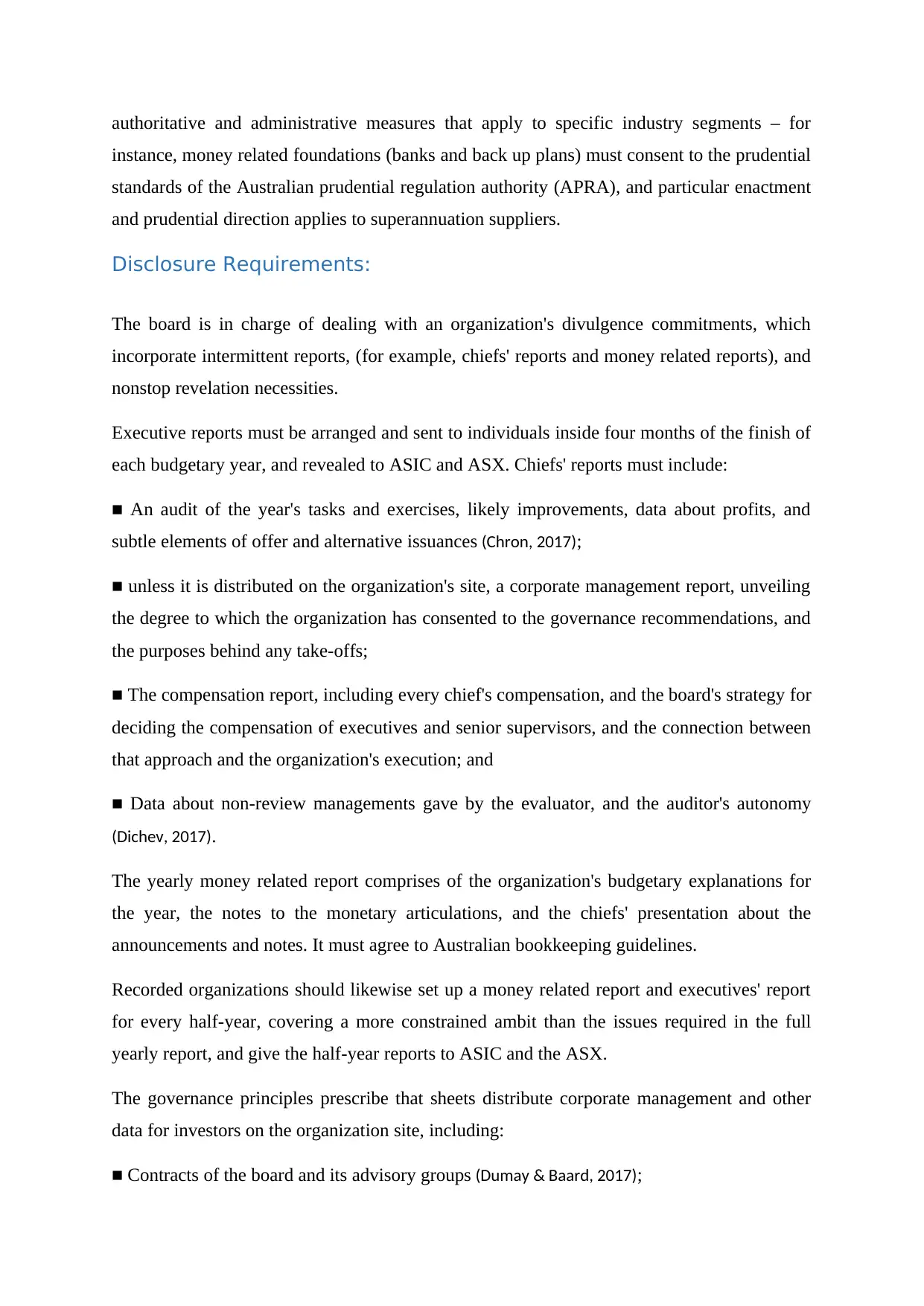
authoritative and administrative measures that apply to specific industry segments – for
instance, money related foundations (banks and back up plans) must consent to the prudential
standards of the Australian prudential regulation authority (APRA), and particular enactment
and prudential direction applies to superannuation suppliers.
Disclosure Requirements:
The board is in charge of dealing with an organization's divulgence commitments, which
incorporate intermittent reports, (for example, chiefs' reports and money related reports), and
nonstop revelation necessities.
Executive reports must be arranged and sent to individuals inside four months of the finish of
each budgetary year, and revealed to ASIC and ASX. Chiefs' reports must include:
■ An audit of the year's tasks and exercises, likely improvements, data about profits, and
subtle elements of offer and alternative issuances (Chron, 2017);
■ unless it is distributed on the organization's site, a corporate management report, unveiling
the degree to which the organization has consented to the governance recommendations, and
the purposes behind any take-offs;
■ The compensation report, including every chief's compensation, and the board's strategy for
deciding the compensation of executives and senior supervisors, and the connection between
that approach and the organization's execution; and
■ Data about non-review managements gave by the evaluator, and the auditor's autonomy
(Dichev, 2017).
The yearly money related report comprises of the organization's budgetary explanations for
the year, the notes to the monetary articulations, and the chiefs' presentation about the
announcements and notes. It must agree to Australian bookkeeping guidelines.
Recorded organizations should likewise set up a money related report and executives' report
for every half-year, covering a more constrained ambit than the issues required in the full
yearly report, and give the half-year reports to ASIC and the ASX.
The governance principles prescribe that sheets distribute corporate management and other
data for investors on the organization site, including:
■ Contracts of the board and its advisory groups (Dumay & Baard, 2017);
instance, money related foundations (banks and back up plans) must consent to the prudential
standards of the Australian prudential regulation authority (APRA), and particular enactment
and prudential direction applies to superannuation suppliers.
Disclosure Requirements:
The board is in charge of dealing with an organization's divulgence commitments, which
incorporate intermittent reports, (for example, chiefs' reports and money related reports), and
nonstop revelation necessities.
Executive reports must be arranged and sent to individuals inside four months of the finish of
each budgetary year, and revealed to ASIC and ASX. Chiefs' reports must include:
■ An audit of the year's tasks and exercises, likely improvements, data about profits, and
subtle elements of offer and alternative issuances (Chron, 2017);
■ unless it is distributed on the organization's site, a corporate management report, unveiling
the degree to which the organization has consented to the governance recommendations, and
the purposes behind any take-offs;
■ The compensation report, including every chief's compensation, and the board's strategy for
deciding the compensation of executives and senior supervisors, and the connection between
that approach and the organization's execution; and
■ Data about non-review managements gave by the evaluator, and the auditor's autonomy
(Dichev, 2017).
The yearly money related report comprises of the organization's budgetary explanations for
the year, the notes to the monetary articulations, and the chiefs' presentation about the
announcements and notes. It must agree to Australian bookkeeping guidelines.
Recorded organizations should likewise set up a money related report and executives' report
for every half-year, covering a more constrained ambit than the issues required in the full
yearly report, and give the half-year reports to ASIC and the ASX.
The governance principles prescribe that sheets distribute corporate management and other
data for investors on the organization site, including:
■ Contracts of the board and its advisory groups (Dumay & Baard, 2017);
⊘ This is a preview!⊘
Do you want full access?
Subscribe today to unlock all pages.

Trusted by 1+ million students worldwide
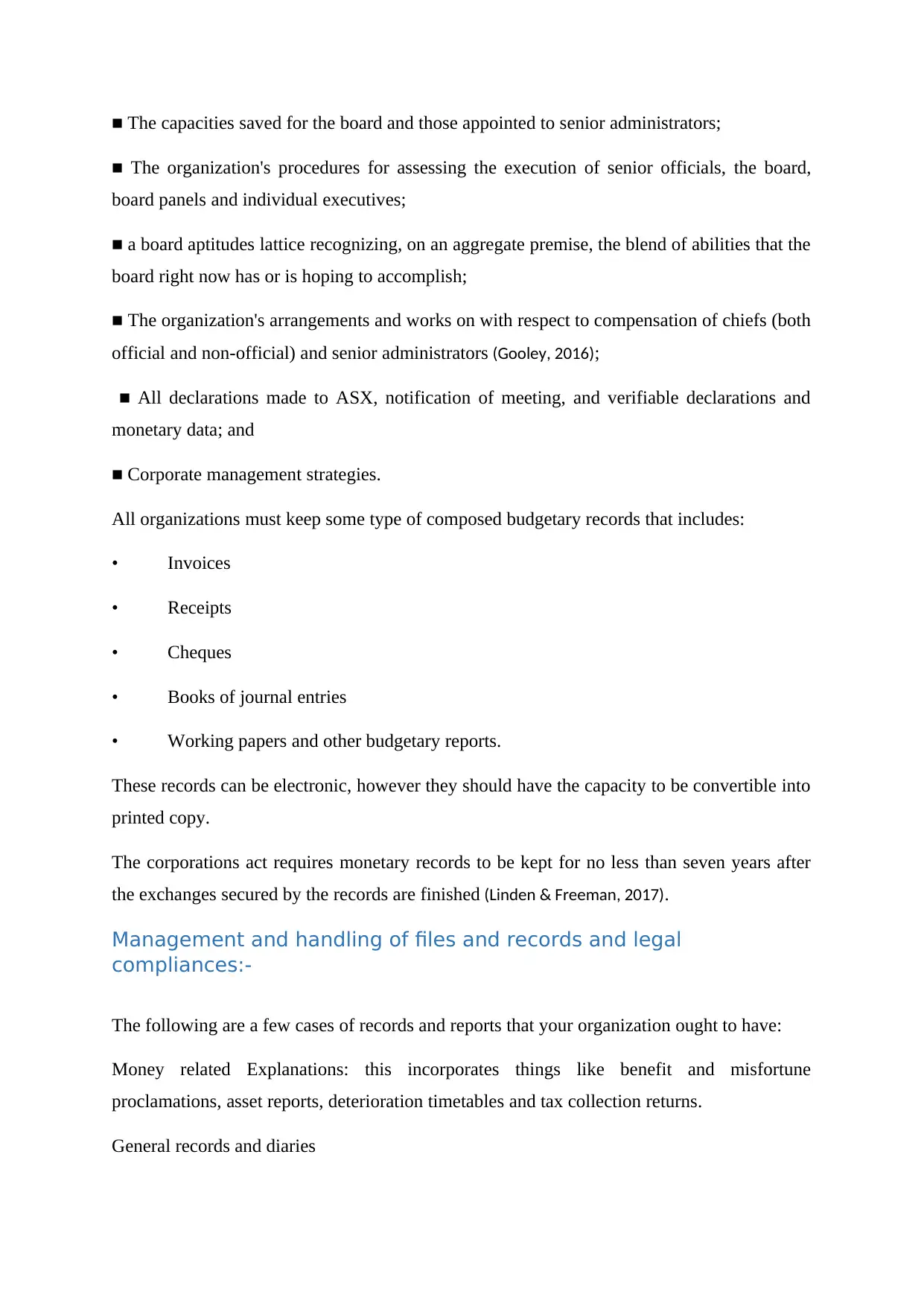
■ The capacities saved for the board and those appointed to senior administrators;
■ The organization's procedures for assessing the execution of senior officials, the board,
board panels and individual executives;
■ a board aptitudes lattice recognizing, on an aggregate premise, the blend of abilities that the
board right now has or is hoping to accomplish;
■ The organization's arrangements and works on with respect to compensation of chiefs (both
official and non-official) and senior administrators (Gooley, 2016);
■ All declarations made to ASX, notification of meeting, and verifiable declarations and
monetary data; and
■ Corporate management strategies.
All organizations must keep some type of composed budgetary records that includes:
• Invoices
• Receipts
• Cheques
• Books of journal entries
• Working papers and other budgetary reports.
These records can be electronic, however they should have the capacity to be convertible into
printed copy.
The corporations act requires monetary records to be kept for no less than seven years after
the exchanges secured by the records are finished (Linden & Freeman, 2017).
Management and handling of files and records and legal
compliances:-
The following are a few cases of records and reports that your organization ought to have:
Money related Explanations: this incorporates things like benefit and misfortune
proclamations, asset reports, deterioration timetables and tax collection returns.
General records and diaries
■ The organization's procedures for assessing the execution of senior officials, the board,
board panels and individual executives;
■ a board aptitudes lattice recognizing, on an aggregate premise, the blend of abilities that the
board right now has or is hoping to accomplish;
■ The organization's arrangements and works on with respect to compensation of chiefs (both
official and non-official) and senior administrators (Gooley, 2016);
■ All declarations made to ASX, notification of meeting, and verifiable declarations and
monetary data; and
■ Corporate management strategies.
All organizations must keep some type of composed budgetary records that includes:
• Invoices
• Receipts
• Cheques
• Books of journal entries
• Working papers and other budgetary reports.
These records can be electronic, however they should have the capacity to be convertible into
printed copy.
The corporations act requires monetary records to be kept for no less than seven years after
the exchanges secured by the records are finished (Linden & Freeman, 2017).
Management and handling of files and records and legal
compliances:-
The following are a few cases of records and reports that your organization ought to have:
Money related Explanations: this incorporates things like benefit and misfortune
proclamations, asset reports, deterioration timetables and tax collection returns.
General records and diaries
Paraphrase This Document
Need a fresh take? Get an instant paraphrase of this document with our AI Paraphraser
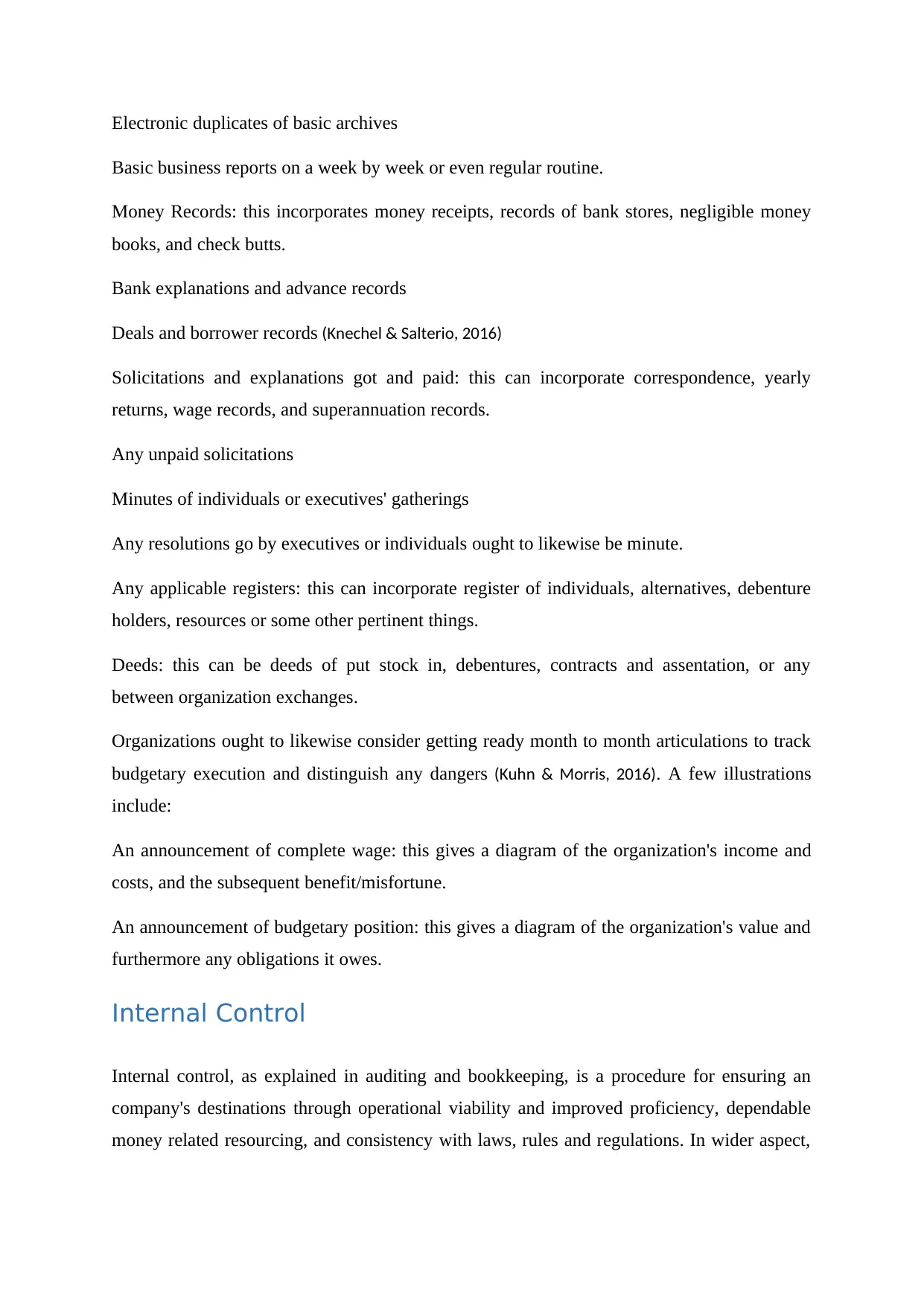
Electronic duplicates of basic archives
Basic business reports on a week by week or even regular routine.
Money Records: this incorporates money receipts, records of bank stores, negligible money
books, and check butts.
Bank explanations and advance records
Deals and borrower records (Knechel & Salterio, 2016)
Solicitations and explanations got and paid: this can incorporate correspondence, yearly
returns, wage records, and superannuation records.
Any unpaid solicitations
Minutes of individuals or executives' gatherings
Any resolutions go by executives or individuals ought to likewise be minute.
Any applicable registers: this can incorporate register of individuals, alternatives, debenture
holders, resources or some other pertinent things.
Deeds: this can be deeds of put stock in, debentures, contracts and assentation, or any
between organization exchanges.
Organizations ought to likewise consider getting ready month to month articulations to track
budgetary execution and distinguish any dangers (Kuhn & Morris, 2016). A few illustrations
include:
An announcement of complete wage: this gives a diagram of the organization's income and
costs, and the subsequent benefit/misfortune.
An announcement of budgetary position: this gives a diagram of the organization's value and
furthermore any obligations it owes.
Internal Control
Internal control, as explained in auditing and bookkeeping, is a procedure for ensuring an
company's destinations through operational viability and improved proficiency, dependable
money related resourcing, and consistency with laws, rules and regulations. In wider aspect,
Basic business reports on a week by week or even regular routine.
Money Records: this incorporates money receipts, records of bank stores, negligible money
books, and check butts.
Bank explanations and advance records
Deals and borrower records (Knechel & Salterio, 2016)
Solicitations and explanations got and paid: this can incorporate correspondence, yearly
returns, wage records, and superannuation records.
Any unpaid solicitations
Minutes of individuals or executives' gatherings
Any resolutions go by executives or individuals ought to likewise be minute.
Any applicable registers: this can incorporate register of individuals, alternatives, debenture
holders, resources or some other pertinent things.
Deeds: this can be deeds of put stock in, debentures, contracts and assentation, or any
between organization exchanges.
Organizations ought to likewise consider getting ready month to month articulations to track
budgetary execution and distinguish any dangers (Kuhn & Morris, 2016). A few illustrations
include:
An announcement of complete wage: this gives a diagram of the organization's income and
costs, and the subsequent benefit/misfortune.
An announcement of budgetary position: this gives a diagram of the organization's value and
furthermore any obligations it owes.
Internal Control
Internal control, as explained in auditing and bookkeeping, is a procedure for ensuring an
company's destinations through operational viability and improved proficiency, dependable
money related resourcing, and consistency with laws, rules and regulations. In wider aspect,
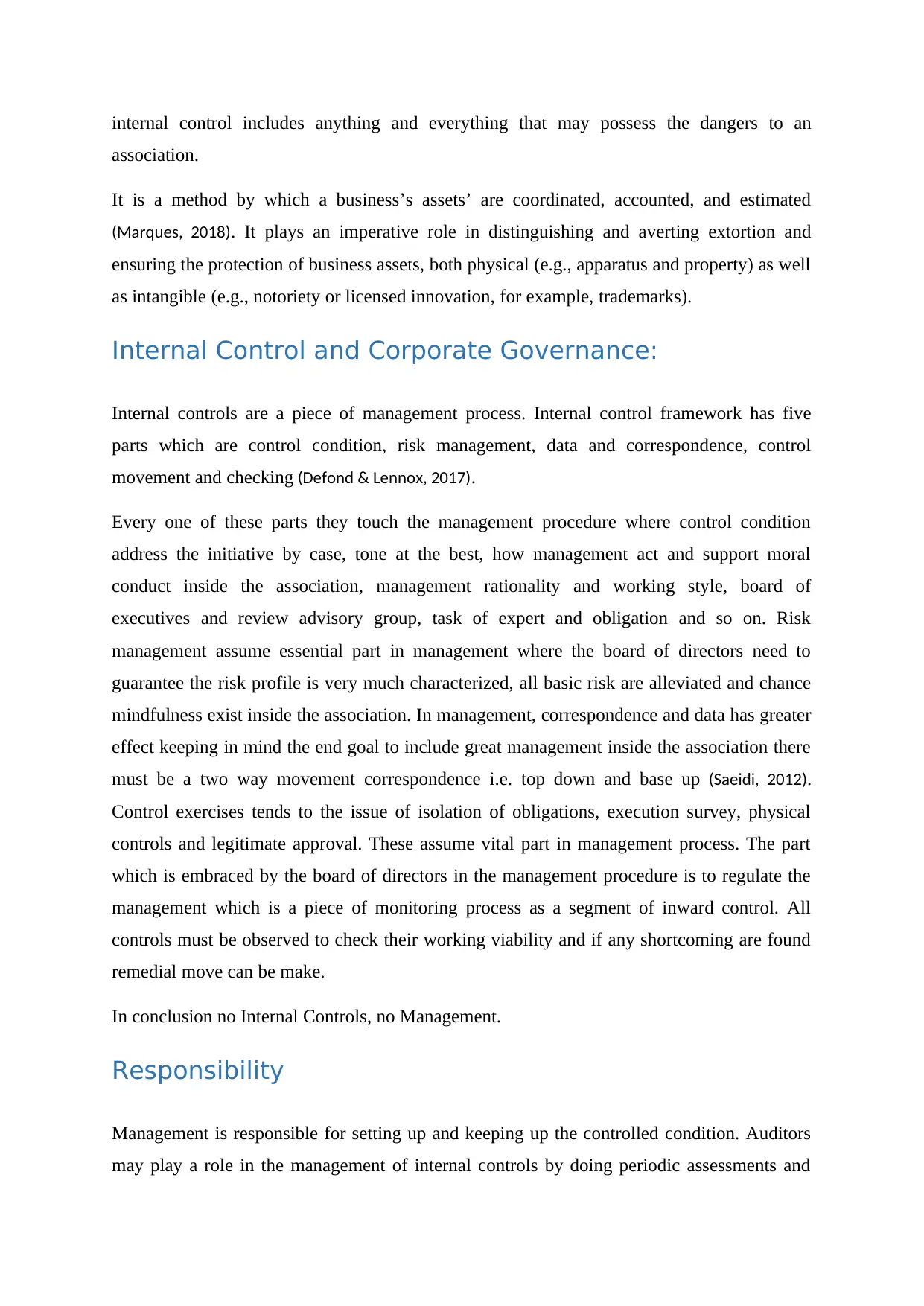
internal control includes anything and everything that may possess the dangers to an
association.
It is a method by which a business’s assets’ are coordinated, accounted, and estimated
(Marques, 2018). It plays an imperative role in distinguishing and averting extortion and
ensuring the protection of business assets, both physical (e.g., apparatus and property) as well
as intangible (e.g., notoriety or licensed innovation, for example, trademarks).
Internal Control and Corporate Governance:
Internal controls are a piece of management process. Internal control framework has five
parts which are control condition, risk management, data and correspondence, control
movement and checking (Defond & Lennox, 2017).
Every one of these parts they touch the management procedure where control condition
address the initiative by case, tone at the best, how management act and support moral
conduct inside the association, management rationality and working style, board of
executives and review advisory group, task of expert and obligation and so on. Risk
management assume essential part in management where the board of directors need to
guarantee the risk profile is very much characterized, all basic risk are alleviated and chance
mindfulness exist inside the association. In management, correspondence and data has greater
effect keeping in mind the end goal to include great management inside the association there
must be a two way movement correspondence i.e. top down and base up (Saeidi, 2012).
Control exercises tends to the issue of isolation of obligations, execution survey, physical
controls and legitimate approval. These assume vital part in management process. The part
which is embraced by the board of directors in the management procedure is to regulate the
management which is a piece of monitoring process as a segment of inward control. All
controls must be observed to check their working viability and if any shortcoming are found
remedial move can be make.
In conclusion no Internal Controls, no Management.
Responsibility
Management is responsible for setting up and keeping up the controlled condition. Auditors
may play a role in the management of internal controls by doing periodic assessments and
association.
It is a method by which a business’s assets’ are coordinated, accounted, and estimated
(Marques, 2018). It plays an imperative role in distinguishing and averting extortion and
ensuring the protection of business assets, both physical (e.g., apparatus and property) as well
as intangible (e.g., notoriety or licensed innovation, for example, trademarks).
Internal Control and Corporate Governance:
Internal controls are a piece of management process. Internal control framework has five
parts which are control condition, risk management, data and correspondence, control
movement and checking (Defond & Lennox, 2017).
Every one of these parts they touch the management procedure where control condition
address the initiative by case, tone at the best, how management act and support moral
conduct inside the association, management rationality and working style, board of
executives and review advisory group, task of expert and obligation and so on. Risk
management assume essential part in management where the board of directors need to
guarantee the risk profile is very much characterized, all basic risk are alleviated and chance
mindfulness exist inside the association. In management, correspondence and data has greater
effect keeping in mind the end goal to include great management inside the association there
must be a two way movement correspondence i.e. top down and base up (Saeidi, 2012).
Control exercises tends to the issue of isolation of obligations, execution survey, physical
controls and legitimate approval. These assume vital part in management process. The part
which is embraced by the board of directors in the management procedure is to regulate the
management which is a piece of monitoring process as a segment of inward control. All
controls must be observed to check their working viability and if any shortcoming are found
remedial move can be make.
In conclusion no Internal Controls, no Management.
Responsibility
Management is responsible for setting up and keeping up the controlled condition. Auditors
may play a role in the management of internal controls by doing periodic assessments and
⊘ This is a preview!⊘
Do you want full access?
Subscribe today to unlock all pages.

Trusted by 1+ million students worldwide
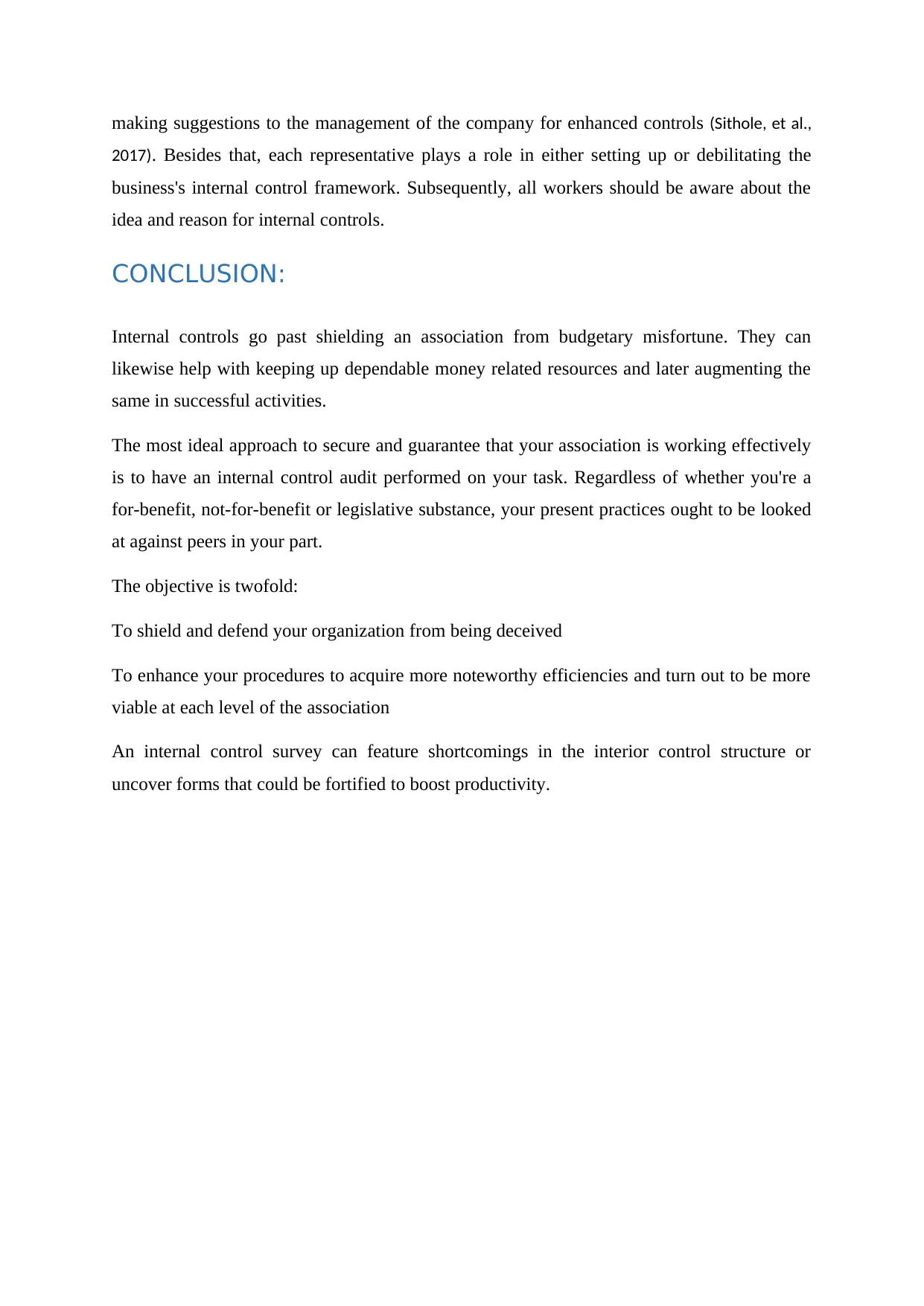
making suggestions to the management of the company for enhanced controls (Sithole, et al.,
2017). Besides that, each representative plays a role in either setting up or debilitating the
business's internal control framework. Subsequently, all workers should be aware about the
idea and reason for internal controls.
CONCLUSION:
Internal controls go past shielding an association from budgetary misfortune. They can
likewise help with keeping up dependable money related resources and later augmenting the
same in successful activities.
The most ideal approach to secure and guarantee that your association is working effectively
is to have an internal control audit performed on your task. Regardless of whether you're a
for-benefit, not-for-benefit or legislative substance, your present practices ought to be looked
at against peers in your part.
The objective is twofold:
To shield and defend your organization from being deceived
To enhance your procedures to acquire more noteworthy efficiencies and turn out to be more
viable at each level of the association
An internal control survey can feature shortcomings in the interior control structure or
uncover forms that could be fortified to boost productivity.
2017). Besides that, each representative plays a role in either setting up or debilitating the
business's internal control framework. Subsequently, all workers should be aware about the
idea and reason for internal controls.
CONCLUSION:
Internal controls go past shielding an association from budgetary misfortune. They can
likewise help with keeping up dependable money related resources and later augmenting the
same in successful activities.
The most ideal approach to secure and guarantee that your association is working effectively
is to have an internal control audit performed on your task. Regardless of whether you're a
for-benefit, not-for-benefit or legislative substance, your present practices ought to be looked
at against peers in your part.
The objective is twofold:
To shield and defend your organization from being deceived
To enhance your procedures to acquire more noteworthy efficiencies and turn out to be more
viable at each level of the association
An internal control survey can feature shortcomings in the interior control structure or
uncover forms that could be fortified to boost productivity.
Paraphrase This Document
Need a fresh take? Get an instant paraphrase of this document with our AI Paraphraser
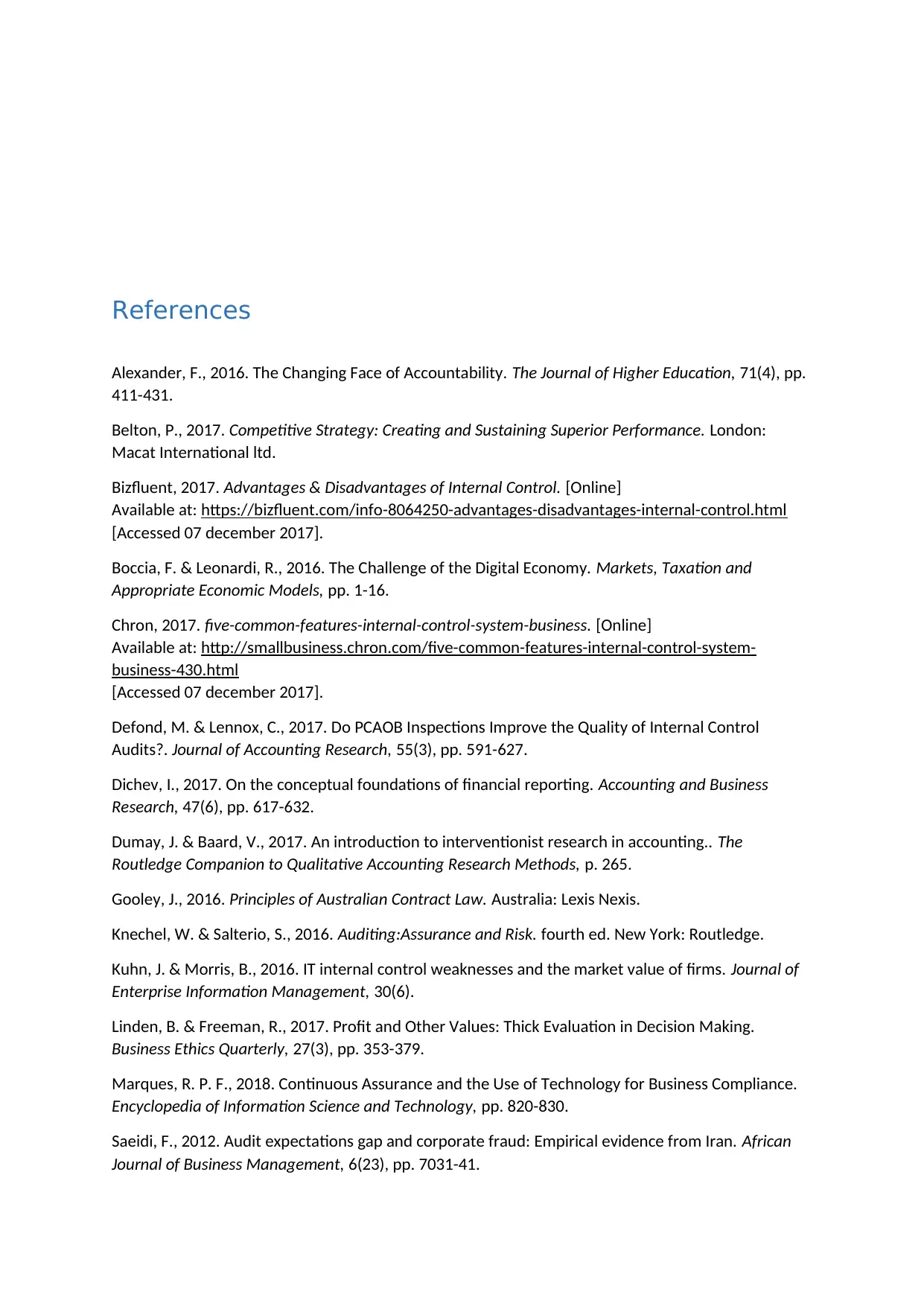
References
Alexander, F., 2016. The Changing Face of Accountability. The Journal of Higher Education, 71(4), pp.
411-431.
Belton, P., 2017. Competitive Strategy: Creating and Sustaining Superior Performance. London:
Macat International ltd.
Bizfluent, 2017. Advantages & Disadvantages of Internal Control. [Online]
Available at: https://bizfluent.com/info-8064250-advantages-disadvantages-internal-control.html
[Accessed 07 december 2017].
Boccia, F. & Leonardi, R., 2016. The Challenge of the Digital Economy. Markets, Taxation and
Appropriate Economic Models, pp. 1-16.
Chron, 2017. five-common-features-internal-control-system-business. [Online]
Available at: http://smallbusiness.chron.com/five-common-features-internal-control-system-
business-430.html
[Accessed 07 december 2017].
Defond, M. & Lennox, C., 2017. Do PCAOB Inspections Improve the Quality of Internal Control
Audits?. Journal of Accounting Research, 55(3), pp. 591-627.
Dichev, I., 2017. On the conceptual foundations of financial reporting. Accounting and Business
Research, 47(6), pp. 617-632.
Dumay, J. & Baard, V., 2017. An introduction to interventionist research in accounting.. The
Routledge Companion to Qualitative Accounting Research Methods, p. 265.
Gooley, J., 2016. Principles of Australian Contract Law. Australia: Lexis Nexis.
Knechel, W. & Salterio, S., 2016. Auditing:Assurance and Risk. fourth ed. New York: Routledge.
Kuhn, J. & Morris, B., 2016. IT internal control weaknesses and the market value of firms. Journal of
Enterprise Information Management, 30(6).
Linden, B. & Freeman, R., 2017. Profit and Other Values: Thick Evaluation in Decision Making.
Business Ethics Quarterly, 27(3), pp. 353-379.
Marques, R. P. F., 2018. Continuous Assurance and the Use of Technology for Business Compliance.
Encyclopedia of Information Science and Technology, pp. 820-830.
Saeidi, F., 2012. Audit expectations gap and corporate fraud: Empirical evidence from Iran. African
Journal of Business Management, 6(23), pp. 7031-41.
Alexander, F., 2016. The Changing Face of Accountability. The Journal of Higher Education, 71(4), pp.
411-431.
Belton, P., 2017. Competitive Strategy: Creating and Sustaining Superior Performance. London:
Macat International ltd.
Bizfluent, 2017. Advantages & Disadvantages of Internal Control. [Online]
Available at: https://bizfluent.com/info-8064250-advantages-disadvantages-internal-control.html
[Accessed 07 december 2017].
Boccia, F. & Leonardi, R., 2016. The Challenge of the Digital Economy. Markets, Taxation and
Appropriate Economic Models, pp. 1-16.
Chron, 2017. five-common-features-internal-control-system-business. [Online]
Available at: http://smallbusiness.chron.com/five-common-features-internal-control-system-
business-430.html
[Accessed 07 december 2017].
Defond, M. & Lennox, C., 2017. Do PCAOB Inspections Improve the Quality of Internal Control
Audits?. Journal of Accounting Research, 55(3), pp. 591-627.
Dichev, I., 2017. On the conceptual foundations of financial reporting. Accounting and Business
Research, 47(6), pp. 617-632.
Dumay, J. & Baard, V., 2017. An introduction to interventionist research in accounting.. The
Routledge Companion to Qualitative Accounting Research Methods, p. 265.
Gooley, J., 2016. Principles of Australian Contract Law. Australia: Lexis Nexis.
Knechel, W. & Salterio, S., 2016. Auditing:Assurance and Risk. fourth ed. New York: Routledge.
Kuhn, J. & Morris, B., 2016. IT internal control weaknesses and the market value of firms. Journal of
Enterprise Information Management, 30(6).
Linden, B. & Freeman, R., 2017. Profit and Other Values: Thick Evaluation in Decision Making.
Business Ethics Quarterly, 27(3), pp. 353-379.
Marques, R. P. F., 2018. Continuous Assurance and the Use of Technology for Business Compliance.
Encyclopedia of Information Science and Technology, pp. 820-830.
Saeidi, F., 2012. Audit expectations gap and corporate fraud: Empirical evidence from Iran. African
Journal of Business Management, 6(23), pp. 7031-41.
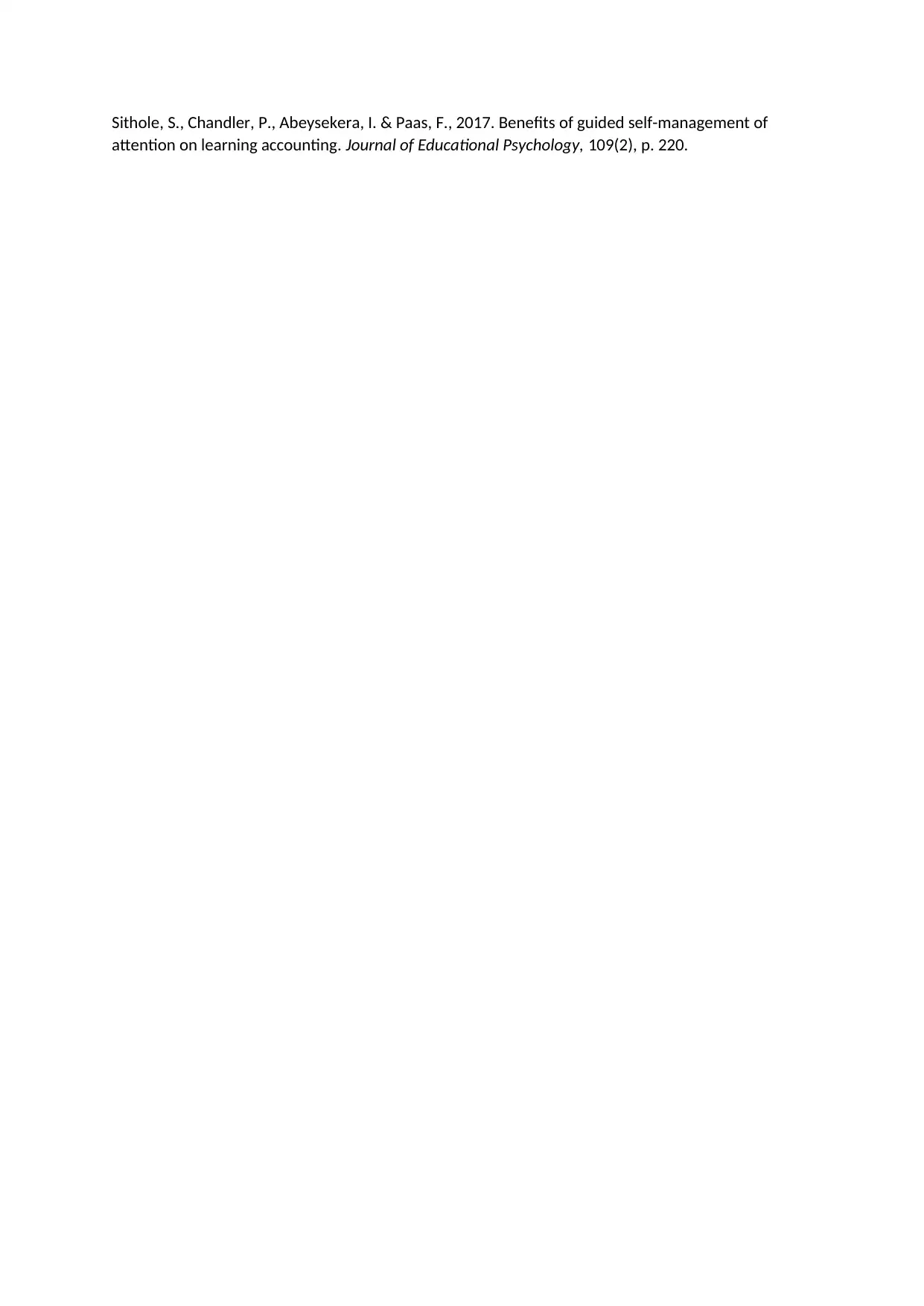
Sithole, S., Chandler, P., Abeysekera, I. & Paas, F., 2017. Benefits of guided self-management of
attention on learning accounting. Journal of Educational Psychology, 109(2), p. 220.
attention on learning accounting. Journal of Educational Psychology, 109(2), p. 220.
⊘ This is a preview!⊘
Do you want full access?
Subscribe today to unlock all pages.

Trusted by 1+ million students worldwide
1 out of 9
Related Documents
Your All-in-One AI-Powered Toolkit for Academic Success.
+13062052269
info@desklib.com
Available 24*7 on WhatsApp / Email
![[object Object]](/_next/static/media/star-bottom.7253800d.svg)
Unlock your academic potential
Copyright © 2020–2025 A2Z Services. All Rights Reserved. Developed and managed by ZUCOL.



